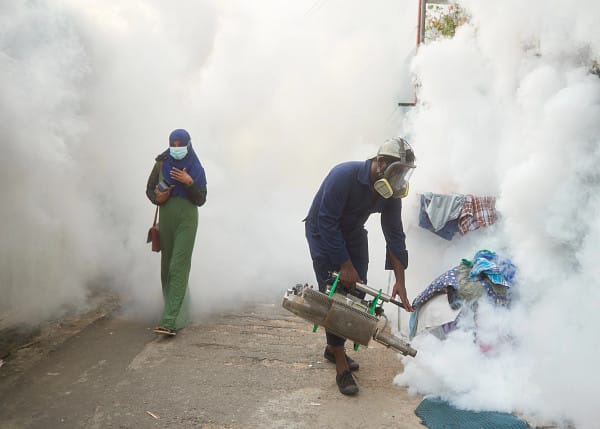Utah's Great Salt Lake (GSL), the largest saltwater lake in the Western Hemisphere, has reached historically low levels in recent years. Like other terminal lakes, GSL is particularly vulnerable to climate change because its water balance relies on river inflows, precipitation, surface runoff, and groundwater—all of which need to offset water loss from evaporation.
Utah's rapid population growth has increased water diversions for human use. Those pressures have exposed a troublesome dust source—a vast expanse of dry lakebed sediments that contain potentially toxic metals, threatening regional air quality and public health. Low water levels have also increased the lake's salinity to levels incompatible with its food webs, raising serious concerns for migratory bird populations and the economy.
Despite legislative action, water levels in the lake remain low. The decline of GSL is largely attributable to human water diversions and can be mitigated by concerted human effort. It is crucial to create strategic initiatives that align human water use with lake preservation efforts. Insights from costly dust mitigation measures at other similar lakes and ecological losses emphasize the urgency for prompt action to increase water levels within GSL.
To facilitate informed decision-making, swift implementation of rigorous air quality monitoring, groundwater levels, and stream flow is imperative. Developing a strategy for residential water management amid population growth and sustained collaboration with agricultural stakeholders are vital components of preservation efforts.
Dust Emission and Exposure
As GSL has receded, more than 800 square miles of lakebed have become exposed. Although much of this playa (dry lake bed) is protected by a surface crust composed of evaporite minerals and clay, dust is routinely emitted from the exposed sediments when the surface is dry and the winds are strong.
Those dust plumes can reduce visibility to less than 1 mile and temporarily increase concentrations of fine particulate matter (PM) above the National Ambient Air Quality Standards (NAAQS) established by the U.S. Environmental Protection Agency (EPA) to protect human health against PM2.5 and PM10, which are particles smaller than 2.5 or 10 micrometers in diameter. (For comparison, the average width of a human hair is around 70 micrometers).
A systematic survey of the GSL playa revealed that dust emission hotspots exist in all four bays of the lake.
Utah's Shrinking Salt Lake
Water levels in the Great Salt Lake have dropped nearly seven meters since the mid-1980s
Dust storms are most likely to occur during spring and fall when strong cold fronts pass through the area. Strong southerly winds in advance of the front push GSL dust to the north and east of the lake, whereas postfrontal northwesterly winds transport it to the south and east. Those wind patterns ensure that all 2.5 million residents along the Wasatch Front can be exposed to GSL dust.
Although much of the dust emitted from the GSL playa will fall out of the atmosphere within a few hours, the smaller particles can remain for up to two weeks. The most likely pathway for human exposure to GSL dust is inhalation, although drinking water or eating food crops that have been contaminated by dust deposition are also potential risks.
Human Health
Exposure to GSL dust is a health concern for all age groups. The risks may begin in-utero, maternal exposure to particulate matter having been linked to preterm birth, serious birth defects, and other health consequences in children. Air pollution is associated with many childhood illnesses, including neurologic developmental problems, childhood cancers, and respiratory illnesses such as asthma and pneumonia.
For children and adults alike, health effects can vary based on particle size. Smaller particles (PM2.5) can penetrate deep into the lungs and are associated with increased risk of reduced lung function, bronchitis, cardiovascular disease, dementia, and premature death in adults. Larger particles (PM10) are more likely to deposit in the upper region of the lung, potentially worsening respiratory diseases such as asthma and chronic obstructive pulmonary disorder.
When the lake maintains healthy water levels, these contaminants are bound to sediments underwater, posing minimal risk to human health
The composition of GSL dust adds another layer of risk. As a terminal lake, GSL has been accumulating contaminants from nearby mining, agricultural, urban, and industrial activities for more than a century. Researchers have detected potentially problematic concentrations of aluminum, antimony, arsenic, chlorine, cobalt, copper, iron, lanthanum, lithium, manganese, uranium, vanadium, and zirconium in GSL sediments and dust.
When the lake maintains healthy water levels, these contaminants are bound to sediments underwater, posing minimal risk to human health. When water levels are low, however, the exposed sediments can generate dust capable of spreading across the Salt Lake Valley and beyond.
Exposure to even small amounts of heavy metals can cause neurologic and other developmental problems for infants and children. Arsenic exposure is linked to cancer, skin lesions, cardiovascular disease, diabetes, and death in young adults. Inhalation of metals such as antimony and arsenic could also cause inflammation of the lungs, chronic bronchitis, chronic emphysema, and lung cancer in adults.
Ecological Losses
The GSL ecosystem is one of the most important wetland habitats in the Intermountain West. As water levels drop in the lake, which has been observed since the 1980s, reduced habitat and increased salinity levels put the endemic species of brine flies and brine shrimp in peril.
Brine flies and brine shrimp feed on algae, bacteria, and organic waste in the lake and help keep the water clean. Those species are also the main sources of food for millions of migratory birds who visit GSL every year. GSL approached a tipping point in 2022, when increased salinity levels caused a significant decline in the brine fly population and affected the remaining population's health, size, and ability to reproduce.
Wetlands surrounding the lake have experienced declines in habitat area and suitability. As wetland habitats degrade, native grasses are replaced by invasive reeds (Phragmites australis) that consume more water, further choke out native species, and are less attractive for migratory birds. Increased dust from the drying lakebed also contributes to earlier snowmelt in the adjacent Wasatch Mountains, exacerbating the region's seasonal water variability and its associated impacts.
Worldwide Occurrences: Consequences and Lessons Learned
GSL is one of many saline lakes around the world that are shrinking in response to climate change and human water use. Some of these are far from Utah, such as Lake Urmia in Iran and Aral Sea between Kazakhstan and Uzbekistan. Others are closer, such as California's Owens Lake, Mono Lake, and Salton Sea. In Utah, scientists and managers are looking to those other lakes as examples of the social and environmental problems that could arise if GSL levels aren't restored.
Owens Lake has become one of the single largest sources of PM10 in the United States, presenting major health concerns for the 40,000 people living in Owens Valley. It is estimated that the cumulative bill for dust control measures at Owens Lake will reach $3.6 billion by next year, with no end in sight; the lakebed must be managed in perpetuity to avoid violating federal air quality standards. Experts at Owens Lake have warned that Utah faces even bigger and more expensive problems if GSL levels remain low; GSL is more than 10 times larger than Owens Lake, with a downwind population 50 times that of the Owens Valley.
GSL is one of many saline lakes around the world that are shrinking in response to climate change and human water use
The size of GSL, its proximity to other dust pollution sources (such as mines), and inadequate air quality monitoring infrastructure in communities near the exposed lakebed limit the ability to quantify the impacts of GSL dust on public health. During the 2023 legislative session, the state aimed to ameliorate some of these challenges by granting the Utah Division of Air Quality $232,000 to expand its PM10 and additional funding to analyze a subset of these new air quality samples for arsenic, lead, and other metals of concern associated with GSL dust. However, a year later, the new PM10 monitors have yet to be deployed. It remains unclear whether communities closest to the lake meet the EPA's clean air standards.
Policy
The Utah State Legislature recognizes the crucial turning point of GSL and agrees that policy action is necessary to ensure its longevity. In 2010, the GSL Advisory Council was established, spurring bipartisan legislation focusing on GSL's sustainable use, protection, and development. From 2018 to 2022, various ongoing preservation initiatives included amendments to water banking, establishment of the Agricultural Water Optimization Task Force, and implementation of Instream Water Flow Amendments.
Additionally, the water trust appropriated $40 million to bolster water flows to GSL, improve water quality, and restore natural habitats. In 2023, the appointment of a GSL commissioner recognized the need to approach decisions regarding GSL from a watershed-wide perspective. The GSL Strike Team's report and the commissioner's Strategic Plan assess immediate and long-term water use and offer recommendations for addressing water needs of GSL.
Regulatory responsibilities of the Division of Water Quality and the Division of Forestry, Fire, and State Lands in regard to the lake were modified. HB453, one of the most significant bills the Utah legislature passed in 2024, mandates water conservation measures for mineral extraction companies.
Other policies include incentivizing homeowners with a turf buyback program offering rebates for waterwise landscaping, creating Utah Water Ways, redefining water reuse projects, prohibiting homeowners associations from requiring landscapes to have more than 50% nonwaterwise plants, designating brine shrimp as the state crustacean for the protection of its natural habitat, setting a salinity concentration limit allowing state regulators to halt mineral extraction, and creating a new GSL license plate, with proceeds going to the Sovereign Lands Management Account.
Although recent legislation and a record-setting snowpack may have temporarily improved GSL's water level, it may not be enough to remediate the lake's current trajectory. Environmental organizations advocate for more drastic policies to address this pressing emergency. A rapidly growing population, climate change and drought conditions, unsustainable landscape practices, and outdated water management will continue to strain Utah's water resources, directly affecting GSL.
The future of GSL is intertwined with our own as well as that of the millions of migratory birds and other organisms that depend on it. By improving water management, humans can effectively address the ecological and human health concerns associated with a shrinking GSL.

ACKNOWLEDGMENTS: The authors would like to thank co-authors James Bemel, Hanna Saltzman, Josh LeMonte, and Kevin Perry for their research and contributions to this piece.












